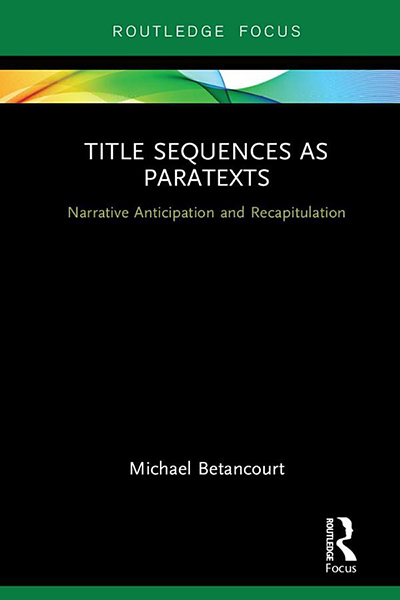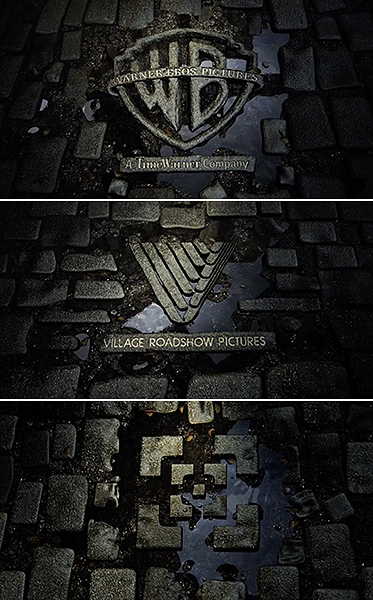PORTFOLIO |
 |
|
|
|
|
|
 |

|
| |

|
| |

|
| |
 |
Title Sequences as Paratexts - Now Available!
story © Michael Betancourt | published November 2, 2017 | permalink |



 |
| 
|
 |


|
 |
|
You can now order my new book Title Sequences as Paratexts: Narrative Anticipation and Recapitulation!

It's part of the Routledge Studies in Media Theory and Practice series, and offers an analysis of the relationship between the title sequence and its primary text�the narrative whose production the titles credit. Using a wealth of examples drawn from across film history�ranging from White Zombie (1931), Citizen Kane (1940) and Bullitt (1968) to Prince of Darkness (1987), Mission: Impossible (1996), Sucker Punch (2011) and Guardians of the Galaxy, Vol. 2 (2017)�Betancourt develops an understanding of how the audience interprets title sequences as instances of paranarrative, simultaneously engaging them as both narrative exposition and as credits for the production. This theory of cinematic paratexts, while focused on the title sequence, has application to trailers, commercials, and other media as well.
|

|
|
|

|
| |
 |
Realism and the Credit Sequence
story © Michael Betancourt | published October 1, 2017 | permalink |



 |
| 
|
 |


|
 |
|
This is an excerpt from my book Title Sequences as Paratexts published by Routledge.
Hollywood has viewed the credits or title sequence as a �distraction� for decades, an interruption interfering with the dramatic realism of the motion picture. This conception can be seen in the ideological �force� of realism that promotes the elimination (or minimization) of the title sequence to start the fabula immediately. However, the �invisibility� of titles has been an ideal for commercial cinema since the Silent Period, as the film historian and documentary theorist Paul Rotha observed in 1930: �a well-titled film is one in which the titles harmonize with the visual images so perfectly that their presence as titles is not remarked.� The crediting function for openings cannot be avoided. Since the title sequence conventionally signifies the start/conclusion of the narrative, the role of narrative in title sequences is always already a given, unavoidable because narratives must begin and end. The conception of text on-screen as a abstraction, stylized, explains the elided title sequence in motion pictures such as Sherlock Holmes (2009) that leaves only the required credits which start the story, the production company logos, but embeds them within the diegetic space on screen; an elaborate main-on-end designed by Danny Yount comes at the conclusion, providing a dramatic ending beyond what appears in the narrative. It is a formal construction guided by the ideological concerns of realism. The attempt to �disappear� the credits into the narrative demonstrates a desire to produce motion pictures comparable to reality, able to displace lived experience and in the process make its idealized fantasy real.

Danny Yount, studio logo graphics from the opening to Sherlock Holmes (2009)
How the audience understands the distinction between the credits and its role for narrative when watching any title sequence is not an either/or opposition. The propositional conflict between peritext::text makes the degree of realism the critical focus, conceiving of the audience as passive, easily manipulated, uncritically accepting and embracing whatever they encounter in the motion picture, the ideological and political aspects of traditional viewership makes the manipulated complicit with their own manipulation, but powerless to challenge it, and possibly even unwilling to consider it is happening. It reifies this historical assumption that audiences are not sophisticated readers consciously choosing their critical or uncritical engagements with the text. Such a passive conception of viewership is incorrect. The audience interprets these designs as part of a state of information where meaning develops from the lower-level d�coupage. These articulations form the title sequence as a particular enunciation in the motion picture as a whole. The range of naturalism::stylization is another lower-level marker for these same issues of narrative function. How closely integrated peritext::text are determines whether the audience will interpret the title sequence as a distinct section, as a introduction flowing into the narrative, or as entirely absent. The relationships between these sequences identify the ideological dimensions of realism::stylization as an interpretive constraint.
|

|
|
read more (1152 words)
|

|
| |
|
|
|